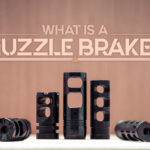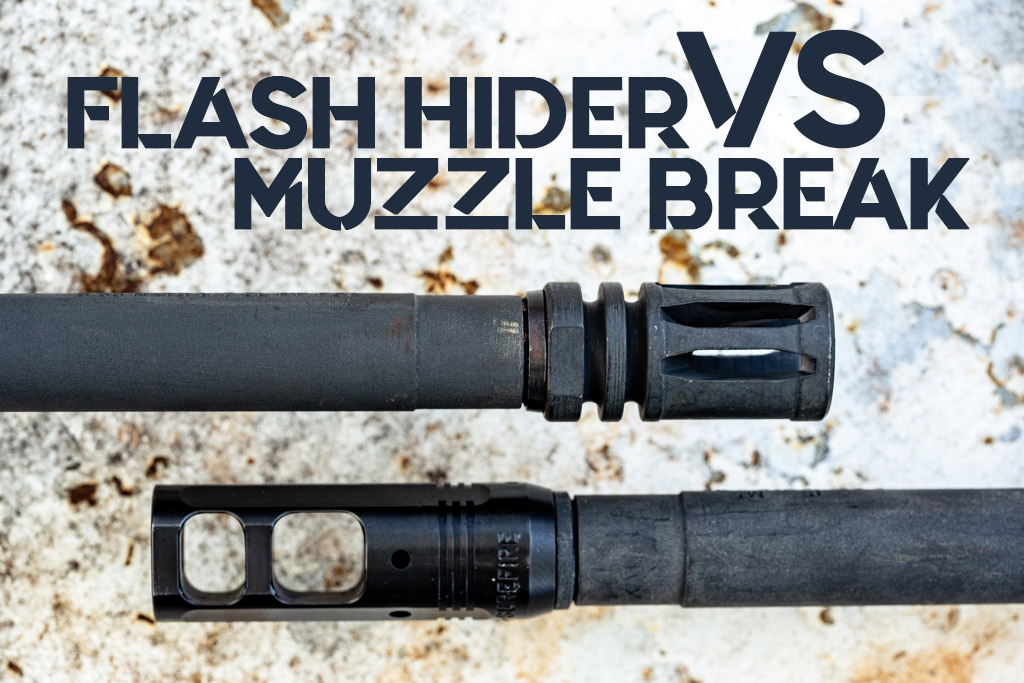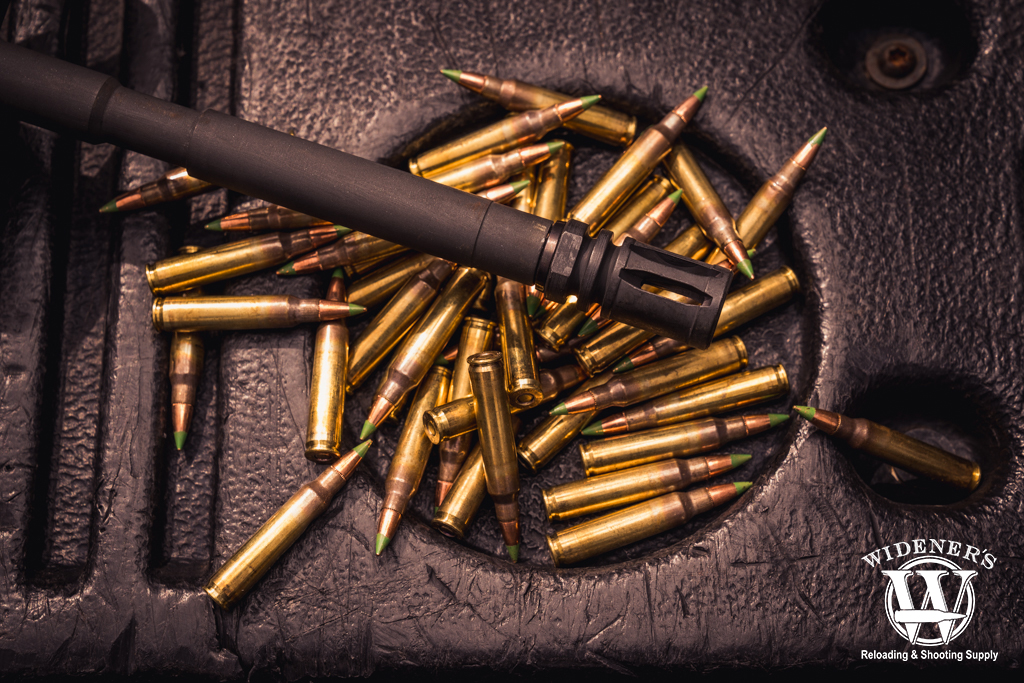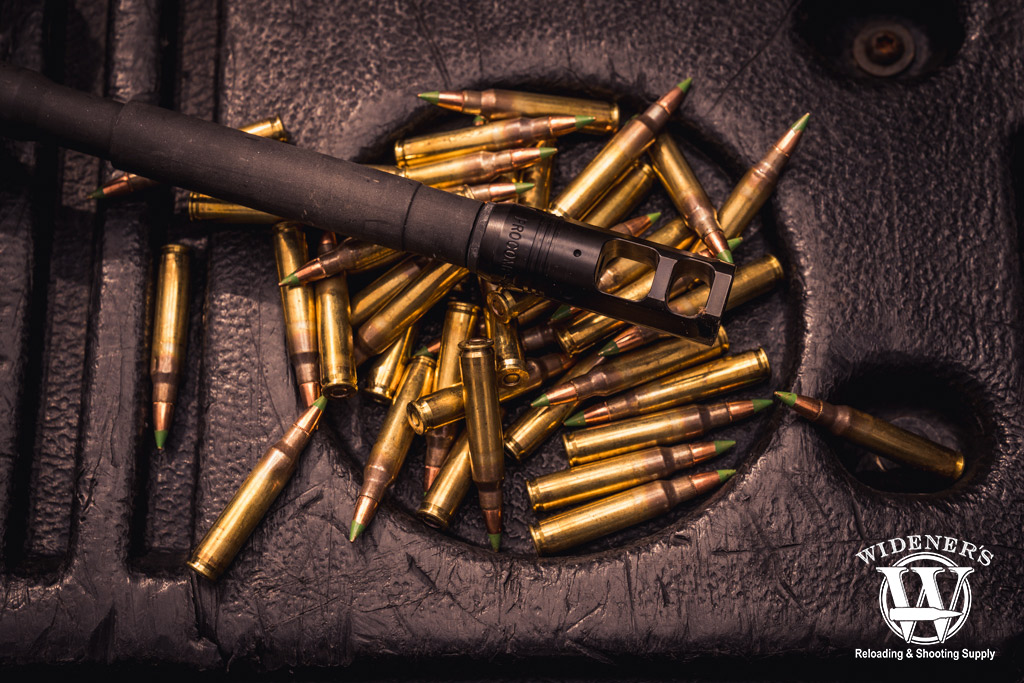

By Guy J. Sagi
Flash hiders reduce visible light generated as a bullet exits a gun and muzzle brakes decrease the amount of recoil reaching the shooter. They occupy the same real estate on a firearm and are often similar in looks, but their respective missions and science harnessed to accomplish them are not identical or interchangeable.
If you look at the end of your rifle barrel, you’ll likely notice an accessory attached to the threads. Thankfully it doesn’t take an advanced degree in physics to understand the differences between a muzzle brake VS flash hider. Here are some things to keep in mind if you’re considering an aftermarket upgrade to your muzzle device or simply want a better understanding of their function.
Multiple Light Sources

A standard A2 flash hider as shown minimizes the visibility of a rifle’s muzzle flash.
There are several sources of light emission at the muzzle with each shot. The most often cited one is rooted in the early development of firearms, when squeezing every foot-pound of energy and accuracy required a long barrel. After smokeless powder’s efficiency arrived, the lengthy and cumbersome tubes were no longer mandatory for performance.
Manufacturers quickly harnessed the new technology with the introduction of nimble guns with shorter barrels. That reduced travel time in the gun increased the amount of incompletely burned propellant jettisoned from the muzzle.
The resulting flames were spectacular enough to be temporarily blinding to shooters at night and even pose a fire danger. Manufacturers today use more efficient powder mixes that burn more completely, even in short barrels.
Powder Burns
Propellant in the process of burning is not the exclusive source of that muzzle flash, either. Particles that haven’t begun ignition can generate another flash when forced into the colder, denser exterior atmosphere. With enough speed and pressure, friction lights them up like a match. The process usually doesn’t take place until the material slows to subsonic speed. That fact dictates this secondary muzzle flash usually occurs at a slightly different location near the barrel.
The third source of light emission mimics the operation of a traditional light bulb. Turn on a switch, resistance in the tungsten filament causes the electricity passing through it to convert into heat and the kitchen basks in a warm glow. In a firearm, particles and gas leave the gun at temperatures high enough to also make them glow.
All these light sources diminish in radiance as they mix and cool with the surrounding atmosphere. Streamlining that process is how flash hiders work.
Flash Suppressor

Flash hider or flash suppressor? The technically correct term is flash suppressor since it cannot “hide” 100% of the light caused by a round being fired.
Today’s flash suppressor designs increase turbulence at the muzzle to reduce light emission and its longevity at each shot. An easy way to envision the approach is to think of a mixing bowl full of white cake batter. Add a single drop of red food coloring and it’s bright and noticeable. It vanishes with mixing, but the speed at which it disappears is determined by how fast the mixer’s blades turn.
To accelerate the mixing of unburned, glowing-hot and flaming particles with the surrounding atmosphere, flash hiders disturb laminar flow at the muzzle. They churn things up and encourage an increased rate of co-mingling—hopefully before the glow blinds the shooter.
History Repeating?
The approach is hardly new. It began sometime around World War II with the introduction of a cone-shaped flash suppressor on a Lee Enfield carbine. The design reduced each shot’s visible light emission, a critical advantage for soldiers who need to preserve their limited ability to see at dusk or night. Many versions followed, including the flash hider on M16 A2s in Vietnam, a still popular model on today’s modern sporting rifles.
Bear in mind, though, even the most efficient combination of flash hider and modern ammunition cannot cloak 100 percent of the light generated at the muzzle during shooting. For that reason, the most technically correct term for these muzzle devices is flash suppressor.
Flash Suppressor Considerations
Modern flash suppressors often look nearly identical, but there are a couple of things to consider during an upgrade or replacement. If you shoot a lot from the prone position, for example, carefully weigh whether you’re okay with vents or ports pointing directly at the ground. The odds are dust and debris will fly with each shot. Even with a shooting mat unwanted powder residue can accumulate below the muzzle.
If you’re interested in any of today’s action sports—or those competitions that emulate sniper missions—dust flying gives away your position much faster than muzzle flash, especially in the daytime. That airborne grime also has a habit of collecting on gun oil.
Most shooters find the managed and small flash up and into line of sight acceptable, but it’s still a consideration. If you’re a predator, varmint of hog hunter using night vision, vents pointing directly up may prove less than optimal.
Muzzle Brake

A muzzle break redirects high-pressure gas to reduce the recoil of a rifle when a shot is fired.
A muzzle brake captures some of the gas energy released with each shot and redirects it to reduce recoil transmitted to the shooter. It sounds simple, but maximizing its efficiency requires venting that minimizes turbulence—the polar opposite of a flash suppressor’s approach.
Designs vary in complexity and efficiency, but the best create high pressure and concentrated streams of gas. Some simply focus the pressure to fight recoil, while others harness a more intricate system.
They are particularly popular on heavy-recoiling big-bore rifles and effectiveness varies by model, manufacturer and even firearm it’s mounted on. Done right they turn uncomfortable firing-line sessions into a pleasant experience.
Muzzle Brake Considerations
It sounds like the ideal solution for most guns, but there are drawbacks. The concentrated streams of gas create an ideal environment for big and bright muzzle flashes. It’s great for nighttime photography at the range, but hardly ideal for every pursuit.
That streamlined pressure also travels further. As a result, don’t be surprised when nearby shooters complain the gun is loud (has a real “bark”). In many cases, again depending on the model, the person behind the trigger won’t detect any audible difference.
Shooting prone from the ground is going to raise a small-but-intense sandstorm at the firing line, even when vents are not pointing directly down. And getting too close to a muzzle brake during firing can even be dangerous.
Despite the drawbacks, it remains one of the most effective and affordable recoil-reduction methods available today. It’s extremely popular with long-distance shooters.
Muzzle Brake VS Flash Hider VS Compensator: Which Option Is Best?

So many options. A muzzle brake (Left), a flash hider (Middle), and a compensator (Right).
Consult local regulations or check with a nearby FFL before upgrading or installing any muzzle device. Some regions of the country have laws preventing their use and/or mounting one in combination with other accessories.
Although installation of a flash suppressor or muzzle brake is relatively simple, check and double-check the thread pattern on your barrel matches that of the device you’re buying. Most AR-15s chambered in .223 Rem. or 5.56 NATO have a thread pattern of 1/2×28—1/2 inch in diameter, with 28 threads per inch. Those figures are not set in stone, however, and some examples of other AR patterns (usually in different chamberings) include 5/8×24 and 1/2×36. Check your gun or barrel manufacturer’s spec before shopping.
Compensators are another muzzle-mounted device that is extremely popular with competitive shooters. Their sole purpose, however, is to direct gas upward, thereby decreasing muzzle rise at each shot.
Despite the visible similarities and shared locations of a muzzle brake VS flash hider, their purpose and approach are completely different. Armed with this knowledge, you’re ready to make that next upgrade to extend hunting hours into the night, or tame that new big-bore beast.
Curious about the differences between Flash Hider VS Compensator? Check out the article here!


